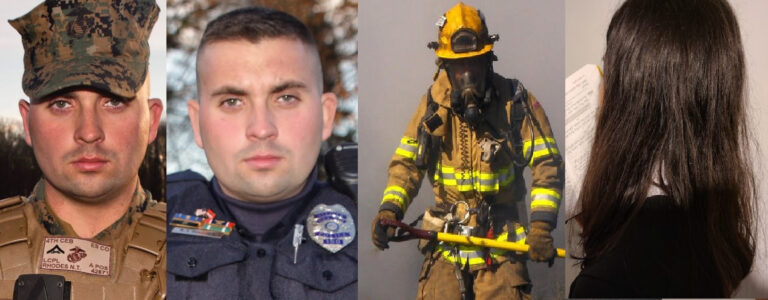By Rabbi Yair Hoffman for 5tjt.com
The reader is probably wondering what those enumerated in the headline all have in common. The answer is that they are all susceptible to injuries such as rucksack palsy, permanent lower back injury, ligament tearing, micro-bleeding, and spinal pain.
- A US Marine carries a helmet, body armor, 2 armor plates, weapons and ammo, light thermal sight, night vision goggles, a rucksack, power source batteries and 3 days of rations – 90 pounds, on average.
- Police Officers must carry a heavy load of equipment, including handcuffs, a duty belt equipment, handgun, flashlight, latex gloves, baton, radio, and pepper spray canister – 20 pounds on average.
- Fire fighters wear and carry a helmet, hood, pants, coat, gloves, boots and air pack – 45 pounds on average.
- A Bais Yaakov girl carries a Vocabulary notebook, Navi notebook, Chumash notebook, Global notebook, Writing notebook, Literature notebook, Literature folder, Math booklets in plastic sheets , World History text-book, Kodesh Folder with Handouts, a pencil case, a Chumash and a Navi – 26.3 pounds on average.
NO LOCKERS
One of the byproducts of COVID-19 is that the New York City Department of Education has legislated that schools eliminate their school lockers in order to ensure that students do not congregate in the hallways. In Bais Yaakov high schools, however, each teacher requires that every student bring in her dedicated notebook to class every day. If you add up all of these notebooks along with a pencil case, a siddur, two seforim, and the 1.25 textbooks that must be brought into class each day – you get the following reality: An average tenth grade girl who weighs, say 130 pounds, carries a full 20.23% of her weight in books and notebooks.
The problem is further compounded by the fact that in the current state of affairs there is no school bussing available. Not only do they shlep it from class to class, they walk back and forth to school with their load.
SERIOUS ISSUE
A number of young women interviewed for this article responded that their backs hurt them all day long. There is more. All research shows that once someone is harmed with a load-carrying injury – they are by far more susceptible to future injuries. There is one more point. Marines carry the load during combat or a during a mission. Bais Yaakov girls in high school do it for a full four years.
THE MITZVOS INVOLVED
- ‘V’ahavta L’rei’acha Kamocha.’ The Ramban, in Toras HaAdam Sha’ar HaSakanah (pp. 42–43), understands the verse of “And love thy neighbor as yourself” as a directive to save our peers from medical danger as well. How can we not have empathy when we see these struggling young girls?
- Hashavas Aveidah. The verse in Parashas Ki Seitzei (Devarim 22:2) discusses the mitzvah of hashavas aveidah, returning a lost object, with the words, “V’hasheivoso lo,” “and you shall return it to him.” The Gemara in Sanhedrin (73a), however, includes within its understanding of these words the obligation of returning “his own life to him as well.” Permanent back pain is no picnic. It is highly probable that it is to this general mitzvah that the Shulchan Aruch refers in Shulchan Aruch Orach Chaim 325.
- ‘Thy Brother’s Blood.’ There is a negative mitzvah of not standing idly by your brother’s blood— “Lo sa’amod al dam rei’echa” (Vayikra 19:16). This is mentioned in Shulchan Aruch (C.M. 426:1) and in the Rambam. When people get permanent injuries because of our inaction, we are violating the commandment of “Lo sa’amod al dam rei’echa.”
- ‘Lo Suchal L’hisalem.’ There is yet another negative commandment associated with the positive commandment of hashavas aveidah, and that is the verse in Devarim (22:3), “You cannot shut your eyes to it.” This verse comes directly after the mitzvah of hashavas aveidah. The Netziv, Rabbi Naftali Tzvi Yehudah Berlin, in his HeEmek She’eilah, refers to this mitzvah as well. Why are we shutting our eyes to these young girls struggling with such a heavy burden?
- ‘V’chai Achicha Imach.’ The She’iltos (She’ilta #37), based upon the Gemara in Bava Metzia 62a, understands the words in Vayikra (25:36), “v’chai achicha imach,” “and your brother shall live with you,” to indicate an obligation to save others with you. The Netziv in his HeEmek She’eilah understands it as a full-fledged obligation according to all opinions. He writes that one must exert every effort to save his friend’s life, until it becomes a matter of pikuach nefesh for himself. A twenty-six pound load for a Bais Yaakov girl is equivalent to a forty pound weight to a 200 pound man. We wouldn’t carry such a weight home – why should we make them do it?
WHAT NEEDS TO BE DONE
These schools need to realize the repercussions that our policies are having on the delicate backs of our daughters. Just like our administrators have spent countless hours in figuring out how to safely open during the COVID-19 crisis – there should be focus groups and teams addressing this issue. Some possible solutions are:
- investing in safe iPads to include notes and textbooks; allowing students to visit their lockers in shifts
- Investing in MiracleBind notebooks and have the teachers add 6 pages at a time. This would eliminate the huge amounts of empty paper in every notebook.
- Changing the locker policy to allow them, but only allow a few people at a time.
- Place shelves in each classroom with the seforim and books on it – with colorful bookcovers so that no one else would take it.
Regardless, it is an issue that needs some serious attention. As a parenthetic note – the problem applies to our young Yeshiva students as well. And the back problems exist among boys as well.
The author can be reached at [email protected]












3 Responses
Here in Israel the problem is further compounded by the fact that older girls are forbidden to use backpacks. Only shoulder bags are allowed.
Thank you Rabbi Hoffman for bringing attention to this. However, this was an issue long before the pandemic. Teachers give homework that require their own class notebook and in many cases textbooks or sefarim that students don’t have at home. You can watch for yourself as students walk down the street with heavy bags on a regular day. And it starts as early as 4th grade. Regardless how you feel about homework in general which is a whole other conversation, homework for all classes should be paper based and fit into a single notebook and folder. A simple start to fixing this is for principals and assistants to watch the girls leave the building at the end of the day and take notice which have the big bags and to start investigating the cause.
loose A4 sheets